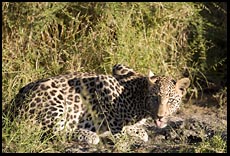
African Photo Safari Guide
by Philip Greenspun; revised August 2018
Africa is the easiest place in the world to photograph wild animals. In most other portions of the globe, animals live in environments that are inaccessible as well as uncomfortably cold and wet. African animals live in a climate very similar to Southern California's. Getting to them is as easy as calling a tour company and having them arrange a Cessna flight to a game lodge's airstrip.
Taking a trip to Africa is easier than going to Los Angeles for the weekend. To visit LA, you would have to decide in which of its 50 subcommunities to stay. You would have to choose a hotel within one of those subcommunities. You would have to rent a car and navigate to your hotel. Waking up the next morning, you would have to decide which of 5000 potential activities to engage in, make a reservation at one of tens of thousands of restaurants, and then pick one of 1000+ nighttime entertainments. By contrast, an African trip might start and end with one email to a travel agent in your home country. They make all of the arrangements with local tour operators and send you an itinerary. After that, you show up at the first airport and the rest requires no thought, planning, effort, or choice. Guides pick you up, tell you when to be ready for dinner or a game drive or whatever, and take you back to your room when it is time to sleep.
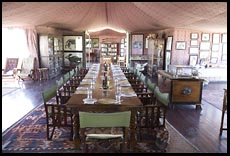
The daily schedule at a game lodge will be something like the following:
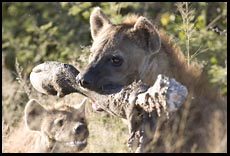
The main health hazard on this kind of trip is obesity. Feeding people five meals per day makes sense when they are spending 12 hours per day toting a heavy rifle through the bush. It isn't such a great idea when all that the guests need or can do is sit in a Land Rover. Very likely you will be less active than you are at home, so try to force yourself to eat less than you would when at home.
Most tourists stay two nights at each lodge. For the best photographic results, try to stay a minimum of three nights in each location. The first day or two will be good for figuring out what is worth photographing on the last day or two.
Here are the fundamental challenges to taking pictures as good as what you see in books or on television:
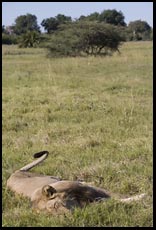
You can cope with the challenge of "animals typically don't do anything interesting" by lowering your expectations. One camp that I visited had leased out an area to a BBC television crew. They had been filming all day every day, and most nights as well, for three years, all in hopes of putting together just a few hours of broadcast-quality footage. Don't expect to get a competitive photo of a common animal; those are typically taken by photographers with months or years to spend in the bush. A great wildlife photographer is someone with a big lens, a big tripod, a big bladder, and a lot of patience. The best photos are taken by people who are competent users of their equipment, but don't necessarily reflect artistic genius.
Try to stay at least three nights at every lodge if your goal is to photograph rather than experience. You will need the first day to figure out where the best photographs are typically made and what kinds of lenses and perspectives are best. You will also use that day to scope out interesting backgrounds such as unusual trees.
Pay extra for a private guide and vehicle (or organize a trip with friends in a group of 6 total). You will be able to leave early, stay out late, skip meals, etc. Maybe you can't stay in the bush for months or years, but you can improve your odds by being in the bush instead of at the buffet.
Animals in Africa have evolved a healthy distrust of humans. They don't want to let you get close enough for a clean shot with a spear or even with a rifle. Despite the large size of many animals, you will need a magnification similar to that afforded by a set of binoculars, which are typically 8-10X. On a full-frame camera, a 50mm lens is normal and 8X multiplication from there corresponds to a 400mm lens or 300mm with 1.4X teleconverter. A lot of exciting views through a pair of binoculars, however, have the subject occupying only a small portion of the field. For birds and far-away larger animals, the most successful images are taken primarily with 600mm and 800mm lenses on a full-frame camera.
The French philosopher Rene Descartes noted that animals move. Thus
you might not have time to change lenses for the perfect composition
before the animal moves away. The most obvious solution to this
problem is a zoom lens. Unfortunately, high magnification zooms tend
not to offer the best image quality. For small sensor Canon body
users, the
If you're using a full-frame sensor camera, the mediocre image quality of the long-range zooms at the long end is going to be noticeable. It is probably better to bring one or two prime telephotos and a 1.4X teleconverter.
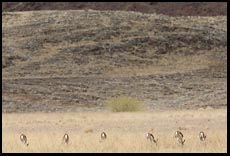 |
Springbok captured with 300/4 lens and 1.4X teleconverter. A little better image quality, but the problem is lack of patience; the animals are simply too far away. |
When an interesting scene presents itself, your guide will stop the Land Rover and shut off the engine to reduce vibration. Nonetheless, at 450mm or 600mm, the magnification of the lens will necessitate high shutter speeds to eliminate blur due to camera shake. The standard rule of thumb is that freezing camera shake requires a shutter speed of 1/focal-length, e.g., 1/600th of a second or faster for a 600mm lens. Fast shutter speeds force a photographer into using very wide apertures, which reduce the depth of field, or high ISO settings, which reduce image quality.
One way to reduce the problem is hiring a private guide and vehicle so that either there are fewer people in the vehicle or all of the people are vibration-conscious photographers and assistants. If you are sitting down in a still vehicle, you could probably get an acceptably sharp image with a 600mm lens at 1/300th of a second. Another path to slower shutter speeds is an image-stabilized lens or camera body. Note that the in-body stabilizers are not that effective for long telephoto lenses. The traditional techniques of tripod and beanbag are not very effective since the Land Rover itself is not perfectly steady. The most important benefit of having a beanbag is that it reduces the strain on your muscles when using long heavy lenses, e.g., anything larger than a 300/4. Sitting in a reasonably still vehicle with an image-stabilized lens, you could probably go two f-stops slower than the standard, e.g., 1/150th of a second instead of 1/600th for a 600mm lens.
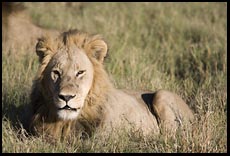
If you've been a casual photographer until now, the use of long lenses and their shallow depth of field will challenge your focusing skills as never before.
Autofocus is a great feature, but keep in mind that the camera is not artificially intelligent. It will autofocus on something, but probably not, by default, the thing that you want it to focus on. What do you want to focus on? If you can't have the entire animal in focus, which you usually can't, focus on the eyes. If the eyes are sharp, viewers will accept unsharpness in the rest of the animal.
With Canon bodies, use Custom Function 4 to move autofocus from the shutter release to the exposure lock button on the rear of the camera.
Keep your camera covered with a shirt or jacket while driving. Keep the camera bag closed. Southern Africa in tourist season is dusty and dry. Bring two bodies along so that you don't have to change lenses in the field.
The typical game drive Land Rover has four rows of seats, each one successively higher. Some professionals prefer to sit in the front seat next to the guide, putting them more at eye level with the animals. One advantage of this seat is that placing a beanbag on the hood is an effective way of reducing arm strain.
As you move farther back in the vehicle, you are sitting progressively higher. This has the advantage of clearer views of animals, who are less likely to be obscured by long grass and low bushes. The disadvantage of being farther back is that more dust blows up from the tires, making changing lenses riskier.
If none of the seats in the Land Rover are working out, consider an aerial perspective. Helicopter charter is available from Maun, Botswana, Victoria Falls (both sides), and a variety of places within South Africa.
More: introduction to aerial photography
On a one-week trip to Africa, it is tough to take the world's best picture of a lion. A lot of photographers have pointed cameras at a lot of lions for a lot of decades. But maybe you can take the world's best picture of your guide, a fellow guest, or the lodge itself. And even if you don't, pictures of the people and facilities behind the scene will be enjoyable souvenirs.
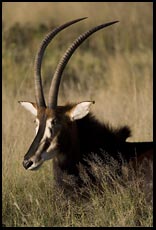
Taking a picture of a moving animal from a moving vehicle is challenging enough. Why add the additional challenge of getting exposure perfect on the spot? That is what you're doing if you store images in JPEG format. Set up the camera to capture RAW instead and you can fiddle with exposure when comfortably sitting at home, or, better yet, deliver the RAW file to a print lab and let their professional technicians optimize a print from the RAW image.
A JPEG is like slide film. An image can be an aesthetic failure due to a 1/2 f-stop exposure mistake. If the animal is posed against an 18-percent gray background, you'll get a perfect exposure from any camera every time. If, on the other hand, the scene is mostly dark trees or light sand, the camera will be fooled into thinking that the light is weaker or brighter than it actually is.
RAW files are like color negatives. The sensor captures a larger range of tones than can be represented on paper. A photographer or lab technician will decide post-exposure which of those tones should be rendered in a final print and at what intensities.
The disadvantages of RAW capture include the following:
Many digital cameras offer the opportunity of simultaneous storing of both RAW and JPEG versions of every image. The JPEGs are useful for quick emailing and printing; you still have the RAWs if you find a favorite image to enlarge.
Most digital cameras can be set to bracket exposures, taking three images in rapid succession for example. The first image will be at the meter's recommended exposure. The second will be 1/2 f-stop underexposed and the third will be 1/2 f-stop overexposed. This is pointless if you are capturing RAW files, which have an exposure latitude of at least +/- 1 f-stop.
Animals tend to move, especially if you drive close to them in a Land Rover. There are two basic approaches to dealing with a moving subject: (1) freeze the motion, or (2) follow the motion.
To freeze the motion of a subject, select a high shutter speed, e.g., 1/250th or faster. To follow the motion of a subject, pan the camera to keep the subject centered in the frame and press the shutter release once the pan is well-established. A shutter speed between 1/30th and 1/125th will generally render the subject sharp and the background blurry. This is a riskier photographic technique, with a lower yield than freezing motion, but the successful images are more interesting than ones taken at a high shutter speed.
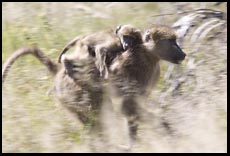 |
Camera panning to follow the running baboon. Note the blurred background. 420mm. f/8 and 1/125th of a second. |
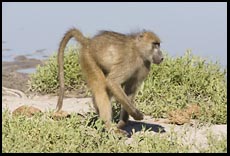 |
A shutter speed of 1/640th of a second was selected to freeze all motion. 420mm and f/8. |
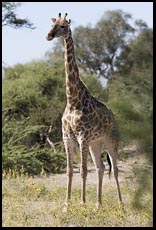
These are recommended starter settings for taking pictures on safari:
Tape the autofocus and image stabilization buttons on the lens so that they aren't accidentally disabled while you are cradling the camera in a bouncing Land Rover. Gaffer's tape will not leave adhesive sticking to the lens. If you are using Canon EOS lenses with ultrasonic motors and Custom Function 4, you will have manual focus available even if the lens is always in autofocus mode.
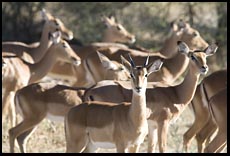
If you're slightly antisocial, unable to relax on vacation, and are willing to carry a bit of extra weight, a laptop computer is definitely worth bringing to the lodges. When everyone else is napping or chatting, you can be transferring, sorting, organizing, rejecting, and captioning images with Adobe Bridge, Picasa, or a similar application.
If you don't want the hassle of carrying a laptop and its power adaptor, simply bring enough memory cards to hold all of your images. Try to sort and caption them as soon as you get home, however, or you're very likely to have forgotten the names of the various animals.
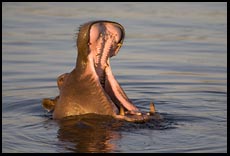
Game lodges are generally off the grid, not that there is much of a grid to begin with in most African countries. Lodges operate generators for at least 12 hours per day. Some high-end lodges have power available in every room, but traditional lodges only have power in the main bar/dining room. They will generally have a power strip to fit European two-prong plugs. It is worth bringing a small adaptor, not a voltage converter, through which to plug in your camera battery charger. Note that laptop computers and camera battery chargers are powered from switched-mode power supplies that accept any voltage between 90 and 240V.
The game lodges are safe, probably safer than any hotel in the U.S. You can leave a camera bag stuffed with the best lenses in the bar while you go back to your room and sleep. You can leave a Rolex on the night table while you went out for a game drive. The rest of Africa is chancier, however, and you may want to take precautions such as having your suitcases sealed in plastic before checking them (this service is available at most African airports for $5 per bag).
As soon as you finish a memory card or a backup, place it into a separate bag from the rest of your camera gear. If your camera equipment is stolen, at least you will have all but your most recent images.
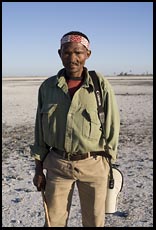
Outfit for the heretofore casual photographer:
Make sure to prepare yourself before the trip so that you aren't reduced to the "green idiot all-automatic mode". Read the owner's manual and take the outfit to a sports event such as a soccer game, trying to follow the players with autofocus. Learn how to capture in RAW and convert to JPEG; you won't have time to get exposure right when you're out in the bush.
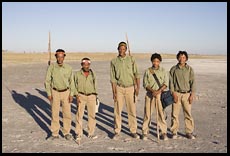
Outfit for the serious photographer:
However you book your trip, do it far in advance. Roads are few and poor in Africa, making air travel essential. In an effort to protect small domestic carriers, governments set tight limits on air travel. The result is that flights are few, far between, and five times as expensive as in the U.S. or Europe. Even if you can get a place in a lodge, you might not be able to get there. People typically book Africa trips six or nine months in advance. If you book last-minute, be prepared for some days cowering in a Jo'burg hotel room or bored in a dusty provincial Botswanan town.
The easiest thing to do is what I did: contact James Weis at Eyes on Africa and let him book the entire trip. He is an experienced wildlife photographer and knows the lodges, the seasons, and the animals.
Text and pictures copyright 2007 Philip Greenspun.
Most of the photos were taken with a